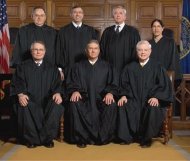5/9/2013
Nebraska Supreme Court Upholds A Little WeavingHonest police officer undermines a common justification for a traffic stop and search.

Police officers who want to stop and interrogate a motorist often claim he "weaved within his lane" as justification. Until now, this common pretext has generally been upheld by the judges around the country. The Nebraska Supreme Court, however, expressed its doubt on Friday.
"Upon our independent review, we find ourselves confronted by the rare case where the law enforcement officer's testimony completely undermines the existence of a reasonable suspicion of criminal activity," Justice William B. Cassel wrote for the court regarding the case of Doan Q. Au.
In the past, the state Supreme Court had upheld stops consisting of as few as two "weaves" that do not cross the center line or lane divider. The justices affirmed these cases on the understanding that it is reasonable to suspect a drunk or sleepy driver was behind the wheel. That assumption changed on Friday when the high court reviewed comments made by Officer Kristopher Peterson of the Douglas County Sheriff's Department.
"In each of those cases involving weaving vehicles, we were not confronted by testimony admitting that the observed behavior 'happens all the time' with unimpaired drivers," Justice Cassel wrote.
Officer Peterson made his observations, confirmed by dashcam video, when he stopped a car with out-of-state plates on Interstate 80 on September 22, 2010 just after 10pm. The vehicle's tires were seen continuing over the left-hand divider line for several hundred feet after passing an uneven stretch of pavement as the highway curved to the left. Cars were merging into the vehicle's lane just before the car drifted to the left a second time. The prosecution insisted this drifting violated the law, and therefore constituted reasonable suspicion to conduct a traffic stop. During the trial, however, Officer Peterson admitted this type of weaving was common, and the Supreme Court justices took note.
"Peterson's own testimony demolished his claim that he had a reasonable suspicion that the driver was intoxicated or fatigued," Justice Cassel wrote. "On cross-examination referring to vehicles touching the lane divider line, he admitted that 'this happens quite a bit' and that it 'happens all the time by people [who] are driving [and who] aren't under the influence or fatigued.' He did not attempt to explain how the circumstances in the case before us differed from what 'happens all the time' with unimpaired drivers."
The justices noted there were several factors that could explain the drifting that had nothing to do with impairment, including the uneven pavement surface, the curve in the road, merging vehicles, the dark of night and the driver's unfamiliarity with the area.
"When we subtract all of these circumstances from the bare touching or crossing of the lane divider line, all that remains is an inchoate and unparticularized hunch," Justice Cassel wrote. "That is not enough."
The court went on to explain the driver did not violate the state law regarding lane changes. The same legal language is used by most states.
"A vehicle shall be driven as nearly as practicable within a single lane and shall not be moved from such lane until the driver has first ascertained that such movement can be made with safety," Nebraska Revised Statutes 60-6, 139 states.
The justices explained the use of the phrases "practicable" and "as nearly as" mean the provision cannot be read as an absolute prohibition on any deviation from a straight line path. A police officer must explain how the driving conduct deviated from the norm and why under the road's particular conditions such driving should be considered unreasonable.
"The district court erred in treating the mere touching or crossing of a lane divider line as a traffic violation," Justice Cassel concluded. "Consequently, the court erred in determining that probable cause existed for the stop."
The appeal was brought not by an impaired driver, but a passenger whose cocaine was discovered after a drug dog was used to search the vehicle. Because the stop was suppressed, the state has no case against the passenger.
A copy of the decision is available in a 170k PDF file at the source link below.


